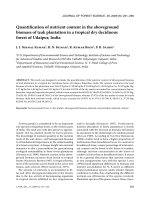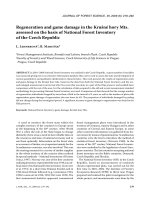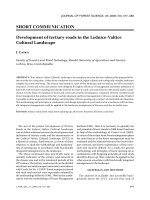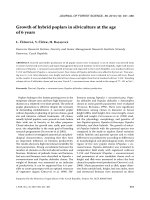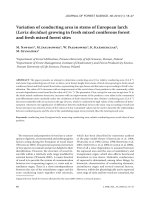Báo cáo lâm nghiệp: "Development of tertiary roads in the Lednice-Valtice Cultural Landscape" pps
Bạn đang xem bản rút gọn của tài liệu. Xem và tải ngay bản đầy đủ của tài liệu tại đây (183.2 KB, 7 trang )
J. FOR. SCI., 55, 2009 (10): 477–483 477
JOURNAL OF FOREST SCIENCE, 55, 2009 (10): 477–483
e aim of the project Development of Tertiary
Roads in the Lednice-Valtice Cultural Landscape
was to define relations between the development and
utilization of tertiary roads and the maintenance of
the Lednice-Valtice Cultural Landscape (LVCL) in
a historical context. Furthermore, in virtue of these
relations, to draft the methodology and fundamen-
tals of opening-up, in accordance with functionally
integrated management in the landscape.
The above-mentioned aims practically mean to
quantify indicators of the tertiary road network in
the chosen area and in the monitored periods of the
20
th
century. e tertiary road network can be divided
into forest and rural transport networks in accordance
with Czech Act No. 13/1997. Forest transport network
and rural road network were separately evaluated by
the methodology of B (1985, 1986) in the combi-
nation with the methodology of Forest Management
Institute (FMI). en it is necessary to quantify the
real potential of forest stands to fulfil forest functions
by help of the methodology of V et al. (2003).
In virtue of these data from forest management plans
the main factors of the forest management must be
evaluated and the relations between the forest trans-
port network and forest maintenance of this none-
such area must be defined. As a result, the general
methodology and principles of forest opening-up in
combination with designing principles of rural roads
should be drawn up. at could also be applied to the
other areas in accordance with functionally integrated
management in the landscape.
MATERIALS AND METHODS
The analysis of available and accessible back-
grounds about the LVCL was the first step of
SHORT COMMUNICATION
Development of tertiary roads in the Lednice-Valtice
Cultural Landscape
J. C
Faculty of Forestry and Wood Technology, Mendel University of Agriculture and Forestry
in Brno, Brno, Czech Republic
ABSTRACT: e Lednice-Valtice Cultural Landscape is an exemplary area that has been influenced by purposeful hu-
man activity for a long time. Under these conditions the nonesuch, highly cultural and ecologically valuable landscape
complex has come into being. e tertiary road system is a part of this landscape and was built as one of its secondary
structures. Forest and rural road systems were designed for higher efficiency of management and better utilization of
land with 73% increase in hauling road density and 16% increase in rural cart-road density in the period under consid-
eration. On the basis of evaluation of forest and rural road network development, evaluation of forest conditions and
forest management the analysis of tertiary road development and forest management in this area can be made. Finally it
is possible to draw up general methodology and principles of forest opening-up in respect of sustainable development.
is methodology and principles in combination with design principles of rural roads and in accordance with function-
ally integrated management could be applied in the landscape management of this area and also in similar ones.
Keywords: tertiary road; forest road; forest opening-up; all-society functions of forest; rural road
478 J. FOR. SCI., 55, 2009 (10): 477–483
methodology development. LVCL was chosen as an
exemplary area that which has been influenced by
purposeful human activity for a long time. Under
these conditions the nonesuch, highly cultural and
ecologically valuable landscape complex has come
into being. Relatively large documentation exists
about the forest management of this complex. e
period of the last hundred years was chosen for the
interpretation of forest opening-up in historical
development, because some changes took place in
social and property right settlement. ese changes
in property rights were connected with the estab-
lishment of the Czechoslovak Republic and with
the development after the years 1945 and 1948. e
beginning of the second part of the twentieth century
was very important from the aspect of landscape
management because new machine technologies
were used in that period.
Transport areas determined in the Regional Plans
of Forest Development (RPFD) were chosen as
model areas for the evaluation of forest opening-up,
of the real potential of forest functions and forest
management. ese transport areas are as follows:
ZI115, ZI116, ZI117 in the Pohansko area, ZI307,
ZI308 in the Horní les area, ZI302, ZI303, ZI304,
ZI306 in the Kančí obora area and ZI402, ZI404,
ZI406, ZI407, ZI408, ZI409 in the Boří les area.
Conditions were evaluated for the years 2000, 1964,
1934, only Pohansko transport areas were evaluated
for the years 2000, 1964, 1924 (common symbol
193x is used in the text for the years 1924 and 1934).
Transport areas ZI300, ZI400 and ZI500 were used
for the evaluation of the rural road system, specifi-
cally their parts without forest land.
The methodology of B (1986), who quan-
tified the indicators of forest opening-up in the
gravitational area, was used for the evaluation of
forest opening-up. e author defined the basin
as a gravitational area, whose watershed forms the
transport ridge and so determines the integrated
area for transport. e methodology was modified
at this point and the forest opening-up was evalu-
ated in the transport areas determined in the RPFD
for Forest Natural Area 35 – Dolnomoravské úvaly
(ÚHÚL 1999). Another modification of Beneš meth-
odology by RPFD methodology was the inclusion of
public roads located inside the transport areas in
forest opening-up quantification. Forest maps and
GIS levels of the opening-up in RPFD were used as
primary resources of data. Other important sources
of information about tertiary roads were old forest
and military maps from the Moravian Provincial
Archives, Forest Management Institute in Brno and
Czech Geodesic Institute. Maps and GIS levels were
compiled by help of ArcView 8.3 software and GIS
levels of forest opening-up were modelled for chosen
transport areas. e transport areas were composed
of forest map grid, level of forest road, level of cho-
sen transport areas from RPFD and level of points
of concentrated fellings. e network of points of
concentrated felling was put into the JTS-K system
so that the first point coordinates x, y = 0.0. Only
points pertaining to the evaluated transport areas
were chosen for further evaluation. Auxiliary levels
were used for the measurement of the length of for-
est roads (L), containing also a logging railway in the
Pohansko area (in 1964, 1924), real skidding distance
(D
s
) and geometric skidding distance (D
g
). D
s
was
measured from the points of concentrated cutting
to the nearest skidding road and along the skidding
road to the forest road, in order to respect water
sheets, eventually the forest boundary. e attributes
of single levels were exported and compiled in the
MS Excel program again. After that, the values of
theoretic skidding distance (D
t
), the density of forest
roads (H) and the efficiency of forest opening-up (U)
were computed. e Beneš methodology modified
only at the point of transport areas was used for the
quantification of length (L) and density (H) of rural
roads. e other parameters were not computed be-
cause the design of rural transport network is fitted
to the ownership of fields.
The methodology of quantification of forest
functions by V et al. (2003) was used for the
quantification of forest condition. e methodology
is based on the ecosystem observation of the forest.
e real potentials of the forest functions (RP
ff
) were
evaluated as a quantified function ability of the real
forests in the optimally possible conditions. e for-
est management books were the main data source.
Data on the single parts of stands with the area, man-
agement groups of stands (MGS), species composi-
tion (tree species and composition), age and forest
type, if it was indicated, were used from the manage-
ment books. Function management groups of stands
(FMGS) were assigned to the management groups of
stands according to the data from Forest Manage-
ment Plan (FMP) 2000–2009, and FMGS according
to the forest type were assigned to the data from FMP
1964–1973. FMGS prevailing in the transport areas
were assigned to the data for the period of 193x (1926
and 1934) when the forest types were not described.
e results are modified databases that were run by a
program developed at the Department of Landscape
Formation and Conservation, Faculty of Forest and
Wood Technology, Mendel University of Agriculture
and Forestry in Brno. is program assigned FMGS
and values of RP
ff
to the single parts of stands. e
J. FOR. SCI., 55, 2009 (10): 477–483 479
program works in the form of an extend macro in
the background of MS Excel. Approximately 50%
of the parts of stands with their forest composition
did not agree with FMGS, which was subsequently
substituted. e standardized forest types and RP
ff
values of the parts of stands in FMP 2000–2009 were
taken from K (2004).
e evaluation of the forest management was done
by the analysis of available data on the forest condi-
tion. ese data contained mainly the numbers from
the tables and text parts of the FMP. e main easily
comparable indicators of forest condition: area, tree
species and age composition of forests, their age
and rotation in the management set of stands were
observed. Information about economic activities
in the management set of stands, harvesting and
transport technologies was acquired above all from
the text parts of FMP.
The necessary information and data were
drawn from the following materials: FMP of the
Židlochovice Forest Enterprise valid for the period
2000–2009 (L 2000), RFDP for Forest
Natural Area 35 – Jihomoravské úvaly (ÚHÚL 1999),
data inventory of the Moravian Provincial Archives
F481 – Břeclav Forest Enterprise (1952) 1956–1973
(it contains only management books, text parts and
forest maps for the working-plan area of Břeclav-
Luh and working-plan area of Břeclav-Písky, which
were obtained from the archives of Forest Manage-
ment Institute, the branch office in Brno). Another
source was the Moravian Provincial Archives F 31
– Lichtenstein Forest Establishing Office in Břeclav
1734–1946. e inventories of Moravian Provincial
Archives F 94 – section Valtice (1391)–1945, F 43 –
section Břeclav 1520–1946, F 313 – Forest District in
Břeclav 1945–1951, F105 – Židlochovice, state for-
ests and farms (1876) 1919–1945 were also studied.
ese inventories contained some references about
forest management in the area of interest but their
content or time span was inapplicable. Contrariwise
the other documents were not found or did not come
down. erefore RP
ff
was not evaluated for transport
areas ZI302, ZI303, ZI304, ZI306 and ZI402, ZI407,
ZI409 in the year 193x.
RESULTS AND DISCUSSION
It is evident from the quantification of forest open-
ing-up in the evaluated transport areas in the pe-
riod 193x–1964 that the total length of forest roads
increased from 184,865 m to 232,064 m and the
density of hauling roads increased from 12.24 m/ha
to 18.97 m/ha. This change can be explained by
the coming of machine technology in harvesting
and timber transport at the end of the 1950s with
increasing demand on technical characteristics of
forest roads. On this account, the reconstruction of
forest transport network was acceded to at the begin-
ning of the period 1964–2000. e reconstruction
partly included the reclassification of forest roads
and above all the construction of forest roads which
enable almost year-long traffic. e total length of fo-
rest roads was reduced to 125,023 m in 2000, which
means a 26% reduction in the period 193x–2000.
But in 2000 the density of hauling roads increased
to 21.19 m/ha. Total increase in hauling road density
was 73% in the period 193x–2000. e total length
of forest roads declined because of advanced costs of
the constructions and repairs of roads. e efficiency
of the forest opening-up was 53.56% in 193x, 45.96%
in 1964 and 53.09% in 2000. e resultant change in
the efficiency of forest opening-up was minimal in
the period 193x–2000.
Comparing with data on the optimal opening-up in
plans, presented by Beneš, we can see a relatively low
number, although the values of forest road density
are corresponding with optimal values. is kind of
opening-up shows the location of forest roads which
very often go along the border of transport areas and
also the influence of nature conditions (favourable
conditions from the aspect of the ground bearing
capacity in the area of Háje and, on the contrary, of
soil with the poor load-bearing capacity in the Po-
hansko area). As we can see in the RPFD, the present
opening-up is sufficient (no construction of forest
roads is planned) although the change in the forest
road density led to an increase value of the real skid-
ding distance in the majority of cases. In technical
terms this change is compensated by the load and
capacity of skidding technology in skidding also to
a longer distance.
e progression of rural road network is a com-
bination of new machine technologies and changes
in ownership rights during the second half of the
20
th
century. Stronger machine technologies al-
lowed farming in large fields and also allowed
planning the rural road network of lower density.
e total length of rural roads 147,987 m and their
density of 38.00 m/ha were highest in 1964. But
finally the values of total length 114,237 m and of
density 29.30 m/ha in 2000 were lower than in 193x
(length 129,193 m, density 33.12 m/ha). A decrease
in total length and density of rural roads was 12%.
e density of cart-roads increased from 5.46 m/ha
to 6.36 m/ha in the period 193x–2000. An increase
in density was 16%. However, this increase was not
continual. In 1964 the density of cart-roads was only
2.29 m/ha. Lower density of rural roads was substi
-
480 J. FOR. SCI., 55, 2009 (10): 477–483
tuted by their higher quality. e basic parameters of
the tertiary transport network are in Table 1.
e forest condition, indirectly expressed by values
of the real potential of forest functions, corresponds
to changes in the tree species composition of forest
stands. e total real potential of forest functions
(ΣRP
ff
) is classified by so-called Class of ΣRP
ff
. In
the period 193x–2000 more than 90% of forest stands
were classified into class III, which means average
ΣRP
ff
. Class II and class IV are represented by a small
percentage of forest stands. Small changes of ΣRP
ff
turned up in virtue of forest management differentia-
tion in accordance with nature conditions. Changes
were set up also by demand for different timber as-
sortments at the end of the forties of the twentieth
century, when forest management was aimed at the
production of thick assortments of the best quality.
erefore were made conversion of sprout forests
into high forests in Háje area. e extension of rota-
tion allowed to increase of forest stands composed
from more than tree species. In 193x were deter-
mined 2 rotations (25 and 100 years), 4 different
rotations (maximum 120 years) in 1946 and finally
10 rotations in 2000 (maximum 150 years). However
main commercial species was not changed. e for-
est transport network is also used as recreational
tracks and for leisure time activities (since 1990
much more intensively). Forest roads also provide
better utilization of social-recreational effects and
health-hygienic functions of the forest. e percent
distribution of classes of ΣRP
ff
is in Table 2.
e development and utilization of forest transport
network in the monitored period corresponded with
demands which were posed on the forest transport
network in terms of forest management. e empha-
sis on forest use from game keeping to logging and
harvesting of minor forest products was relocated
at the beginning of the twentieth century. e forest
road alignment, their constructional facilities and
their classification have been changing depending
on changes in the forest management and technolo-
gies. ese changes have a long-term character con-
nected with costs of constructions of forest transport
network. But for technical and economic reasons,
these changes did not correspond with the speed of
changes connected with the implementation of skid-
Table 1. e basic parameters of tertiary road network
Transport
area
Period
H
(m/ha)
U
(%)
Period
H
(m/ha)
U
(%)
Period
H
(m/ha)
U
(%)
ZI115
193x
27.36 44.42
1964
28.02 44.07
2000
23.29 64.92
ZI116 18.55 61.85 27.44 55.23 20.60 39.60
ZI117 13.64 56.64 15.56 46.38 18.67 54.18
ZI302 10.42 56.69 12.31 41.95 28.30 44.65
ZI303 7.98 61.21 18.62 59.08 12.26 81.24
ZI304 0.00 0.00 15.16 88.67 24.24 56.74
ZI306 8.84 58.14 14.15 52.40 14.59 38.90
ZI307 15.94 47.02 6.32 84.05 21.97 64.04
ZI308 8.54 58.71 8.47 57.42 23.57 32.88
ZI402 17.02 40.05 45.63 29.99 33.84 46.76
ZI404 13.56 49.62 26.70 59.96 29.51 51.87
ZI406 22.79 29.95 30.15 58.17 28.92 51.01
ZI407 10.60 43.13 13.32 38.92 23.36 58.46
ZI408 19.40 37.68 20.17 40.64 33.75 48.60
ZI409 16.80 49.66 24.52 51.66 29.40 27.04
ZI300 27.17 – 38.65 – 20.90 –
ZI400 46.71 – 49.77 – 42.49 –
ZI500 14.92 – 19.79 – 15.44 –
J. FOR. SCI., 55, 2009 (10): 477–483 481
der technologies, let us say the speed of implementa-
tion of these technologies did not correspond with
the condition of the forest transport network.
Like the changes in forest management, some
changes connected with landscape management
have an effect on the forest transport network. e
forest transport network was originally designed in
conformity with the conception of landscape park,
let us say only its component unit was used. e
forest transport network represents a historical
secondary landscape unit, respecting specific nature
conditions.
In this case there were changes mainly in the
flood plain area. ese changes were caused by the
regulation of the Dyje River as prevention against
the spillage of flood water to the forest stand, which
was harmful to the forest transportation network.
Contrariwise, the ameliorating channel construc-
tions influenced the conditions of skidding.
e ameliorating channels increase costs of con-
structions and repairs of the forest transport network
because it is necessary to build bridges across these
channels. e forest transport network was an inte-
gral part of landscape during the whole monitored
period, also in terms of its opening-up. e forest
transport network is connected to the network of
other tertiary roads and highways and is also used as
forest department border in forest management.
e methodology used for the project solution
has proved good by determination of evaluated ar-
eas as transport areas appointed within RPFD. e
transport areas respect the borders of forest owners
and spatial arrangement of the forest. at is why
there are no problems with the forest condition
evaluation (the borders of transport areas do not
cut forest stands). Because the spatial arrangement
of the forest is principally resistant in the historical
context of the evaluated area, transport areas can be
determined on the basis of forest maps from vari-
ous periods. Determined transport areas were not
affected by the realignment of the Dyje River. e
realignment was the cause of watershed contour
change and the rise of new watersheds in the area of
floodplain forests. In this regard, the evaluation of
opening-up in the watersheds by the methodology
of Beneš was a little bit questionable, the same as the
Table 2. Classes of ΣRP
ff
– percent distribution
Period
Class
of ΣRP
ff
ZI115 ZI116 ZI117 ZI307 ZI308 ZI404 ZI406 ZI408 Sum
2000
I 0.0 0.0 0.0 0.0 0.0 0.0 0.0 0.0 0.0
II 8.6 5.8 7.5 10.1 12.4 0.2 1.2 0.0 4.5
III 91.4 94.2 92.5 89.9 87.6 94.4 91.3 98.4 93.4
IV 0.0 0.0 0.0 0.0 0.0 5.4 7.4 1.6 2.1
V 0.0 0.0 0.0 0.0 0.0 0.0 0.0 0.0 0.0
VI 0.0 0.0 0.0 0.0 0.0 0.0 0.0 0.0 0.0
1964
I 0.0 0.0 0.0 0.0 0.0 0.0 0.0 0.0 0.0
II 1.5 0.8 10.0 0.0 1.8 0.2 1.6 0.3 2.2
III 98.5 99.2 90.0 100.0 98.2 99.5 88.4 95.1 95.3
IV 0.0 0.0 0.0 0.0 0.0 0.2 10.0 4.5 2.6
V 0.0 0.0 0.0 0.0 0.0 0.0 0.0 0.0 0.0
VI 0.0 0.0 0.0 0.0 0.0 0.0 0.0 0.0 0.0
193x
I 0.0 0.0 0.0 – – – 0.0 0.0 0.0
II 0.0 0.0 1.8 – – – 0.0 0.3 0.4
III 100.0 100.0 98.2 – – – 100.0 91.8 97.3
IV 0.0 0.0 0.0 – – – 0.0 7.8 2.3
V 0.0 0.0 0.0 – – – 0.0 0.0 0.0
VI 0.0 0.0 0.0 – – – 0.0 0.0 0.0
482 J. FOR. SCI., 55, 2009 (10): 477–483
subsequent evaluation of forest condition and forest
management.
e rural transport network is designed in differ-
ent conditions from those of the forest transport
network. Natural (mainly terrain) conditions, or-
ganization, technologies and production time are
different. e design of a rural road has to agree
with the ownership structure of land. But rural
roads often make a connection between forest and
public transport systems. erefore it is important to
recognize also connecting function of rural roads,
their condition and bearing capacity in the design
process of the forest transport system. e intercon-
nection of forest and rural roads is also important for
better utilization of all forest functions.
e proposed methodology and principles of for-
est opening-up result from the methodology used for
the project solution and conventions of opening-up
formulated by Beneš. e conventions are completed
by specifics resulting from nature and management
conditions in the evaluated area and they are in con-
formity with functionally integrated management.
e procedure contains the following events:
– preparative works round-up and contingent data
base update of the evaluated area, shown in RPFD
and FMP. ere are maps (stand map or contour
and typological map), descriptions of current
opening-up, descriptions of forest stands and
management instructions for single management
sets of stands;
– evaluation of the present forest opening-up condi
-
tions – to control the connection and its condition
with public or other tertiary roads, within deter-
mined transport areas according to RPFD, calcula-
tion of opening-up indicators according to Beneš;
– comparing numbers of present opening-up in
-
dicators with indicators of optimal opening-up
according by Beneš;
– optimization of forest transport network – on ac
-
count of nature management conditions in view of
specific limitation from further exploitation of the
area so as the numbers of opening-up indicators
were closest to optimal numbers.
CONCLUSIONS
On the basis of analysis results few expert conclu-
sions can be drawn. e total length of forest roads
was reduced by 26% but the total increase in hauling
road density was 73% in the period 193x–2000. At
-
tained values of opening-up effectivity in 2000 are a
little bit lower – on average about 50%. e location
of forest roads along the borders of transport areas
has an influence on the low number of opening-up
efficiency as well as nature conditions, especially in
the floodplain forests. Development of the rural road
system was similar to forest roads with a reduction in
total length and 16% increase in cart-roads density.
e forest condition, indirectly expressed by values
of real potentials of forest functions, corresponds
with changes in the tree species composition of
forest stands. In the period 193x–2000 more than
90% of forest stands were classified into class III.
e change in the tree species composition of forest
stands was a result of forest management differen-
tiation according to nature conditions and also of
changed demand for produced assortments at the
end of the forties in the twentieth century. e exten-
sion of rotation allowed to increase of forest stands
composed from more than tree species. But main
commercial species was not changed. (only the spe-
cies composition was changed). In the whole moni-
tored period development and utilization of forest
transport network corresponded with necessaries
that were imposed on the forest transport network in
terms of forest management. Changes in landscape
management were also reflected in the forest trans-
port network. ese changes were above all in the
area of floodplain forests after the regulation of the
Dyje River. e interconnection of forest and rural
roads in the tertiary road system is also important
for better utilization of all forest functions.
The proposed methodology and principles of
landscape opening-up are based on the methodology
used for the project solution. e expert conclusions
enable the general application of acquired findings
in the Lednice-Valtice Cultural Landscape and in
the other areas, mainly with a similar potential of
utilization and sustainable development.
R ef er en ce s
BENEŠ J., 1985. Teoretické základy optimalizace lesní do-
pravní sítě. Brno, VŠZ, LF: 47.
BENEŠ J., 1986. Optimalizace lesní dopravní sítě. Lesnictví,
32: 1089–1114.
KUPEC P., 2004. Real potentials of social forest functions of
selected forest stands at Židlochovice Forest. Journal of
Forest Science, 50: 190–198.
LESPROJEKT, 2000. Lesní hospodářský plán pro LHC
Židlochovice. Brno, LESPROJEKT Brno, a. s.: 544.
ÚHÚL, 1999. Oblastní plán rozvoje lesů – metodika. Brandýs
nad Labem, Ústav pro hospodářskou úpravu lesů: 172.
VYSKOT I. et al., 2003. Kvantifikace a hodnocení funkcí lesů
České republiky. Praha, MŽP ČR: 194.
Received for publication September 24, 2008
Accepted after corrections May 15, 2009
J. FOR. SCI., 55, 2009 (10): 477–483 483
Vývoj účelových komunikací v lednicko-valtickém areálu
ABSTRAKT: Lednicko-valtický areál je ojedinělé území, dlouhodobě ovlivňované cílevědomou lidskou činností.
Postupně tak vznikla kulturní, intenzivně využívaná krajina. Síť účelových komunikací je součástí této krajiny jako
jedna z jejích sekundárních struktur. Lesní a polní cesty byly budovány s cílem zajištění vyšší efektivity hospodaření
a lepšího využití půdy s nárůstem hustoty lesních odvozních cest o 73 % a 16 % u hlavních polních cest ve sledovaném
období. Na základě zhodnocení vývoje lesní i polní cestní sítě, zhodnocení vývoje stavu a hospodaření lesa může
být provedena analýza vývoje účelových komunikací a hospodaření v lese tohoto unikátního území. Ve výsledku lze
navrhnout metodiku a zásady zpřístupnění lesa respektující předešlý vývoj. Tato metodika a zásady – v kombinaci
se zásadami návrhu polních cest a s ohledem na funkčně integrované hospodaření – mohou být použity v manage
-
mentu lednicko-valtického areálu nebo i jiných obdobných území.
Klíčová slova: účelová komunikace; lesní cesta; zpřístupnění lesa; celospolečenské funkce lesa; polní cesta
Corresponding author:
Ing. J C, Mendelova zemědělská a lesnická univerzita v Brně, Lesnická a dřevařská fakulta,
Lesnická 37, 613 00 Brno, Česká republika
tel./fax: + 420 545 134 083, e-mail:


